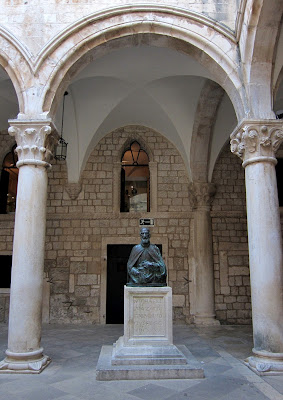
6日もドブロヴニクに滞在したのに、文化財、美術館や教会などの観光はほとんどしていません(^ ^;) なにせ、ランチを食べてからは夕方までシエスタだったので、開館時間内に行動できる時間が限られてしまいました・・・。その限られた時間内に一応訪れたのがここ、総督邸(Knežev Dvor)。ここはドゥブロブニクが共和国として繁栄したころ、政治の中心として使われていた場所です。
We stayed in Dubrovnik for 6 days, but didn't have much time to visit cultural and heritage attractions, museums and churches, mainly because we had siesta after lunch til evening. It was really hot while the sun was high up in the sky, so it was good to have siesta, also we wanted to take photos of Dubrovnik early in the morning and night. So, in our limited time for sightseeing, we decided to visit the Rector's House (Knežev Dvor). This palace was used as the administrative centre of Dubrovnik when the city prospered as a republic (back in time, it was called as "Ragusa Republic").

ここにはラグーサ共和国の政治機関、代表気概、小評議会が置かれただけではなく、裁判所もあったみたい。そして、権威の象徴である「総督」が住んだ場所でもあります。でも汚職や独裁に走らないように、任期はたったの1か月だった様です。しかも、その1か月間は無給だったとか・・・!金もうけのためじゃなく、国民のための政治。その精神は、今はどこへやら・・・。
The Major Council, the Minor Council, and the court were placed in this palace, also, the Dubrovnik Rector resided there. The Rector was chosen each month as a symbol of authority. The serving term of the Rector was very short as 1 month, because it is said to avoid the Rector to seize the power to create dictatorship and to be corrupted. It is notable that the Rector served his job with no salary. So, yeah, long long time ago in Croatia, there was an ideal model of politics, and it seemed to work very well.

ドゥブロブニクは軍隊を持たない共和国だったそうです。軍隊のないこの小さな都市国家が繁栄した裏側には、しっかりとした要塞設備と巧みな外交手段によるものだそう。オスマン帝国に攻められた際も、税金を払うことで共和国の独立と貿易を守ることに成功したらしい。ちなみに、1416年にはすでに奴隷制度も廃止していて、ロヴリィエナッツ要塞の入口のモットーにあるように、自由を大切にしていたことがうかがわれます。
According to the guide book I've got with Dubrovnik Card, Dubrovnik Republic didn't have its own army. Dubrovnik wouldn't have prospered without its strong defensive fort system and skillful diplomacy. In fact, when the Ottoman Empire attached the city to seize it, the republic succeeded in negotiating with Turks and both agreed to keep the autonomy of the republic by paying tax to the Ottoman Empire. Apparently, the tax was not as high as to collapse the republic, rather, Dubrovnik enjoyed its prosperity through trading with all over Europe while being protected (kind of) by the Ottoman Empire.
総督邸の中はそんなに広くないものの、中庭の階段や階段など、なかなか美しい作りになっています。展示物は決して多くなかったですが、その中でも金庫かな?宝箱のような箱に施されたものすご~く複雑で芸術品のようなカギのシステムが面白かったです。
The guide book states that Dubrovnik Republic abolished slavery and prohibited slave trading back in 1416. This tells that freedom is the motto of Dubrovnik, as seen on the entrance of Lovrijenac Fort.
Well, the inside of the palace was not that big, but it remains beautiful architecture such as the stairway and the gallery at the entrance. There weren't many things exhibited, although I was interested in small boxes, which I think were used as the safe or treasure boxes. They have very complex and detailed but very beautifully made artistic key lock system.

階段の手すりにこの手の彫刻がありました。何か意味があるのかな・・・?
All the railing of steps were held by this hand sculpture. Not sure if it has any meaning though....

このドアの上には、ドゥブロブニクが共和国だったころに政治モットーがラテン語で「Obliti Privatorum Publica Curate」と刻まれています。意味は「私事は忘れ、公共のために尽くせよ」。権力を握る人に対する戒めのようです。政治のあるべき姿をみた、と思いました。当然のことなのに、今の世界では完全に忘れられていること。
The letters inscribed on the door reads "Obliti Privatorum Publica Curate", meaning "Forget private affairs, take care of public ones". This was the basis political motto of the Dubrovnik Republic and inscribed at the door of the Rector's Palace to remind all those in power. What a nice phrase!

夜のライトアップされた総督邸。黄金に輝いていて、まるで昔の栄華を再現しているかのよう。
The Rector's Palace at night. It looks as if shine gold :)

0 件のコメント:
コメントを投稿